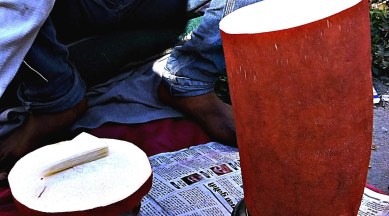📣 For more lifestyle news, click here to join our WhatsApp Channel and also follow us on Instagram
Ram Kandmool: A ‘mysterious roadside treat’ that takes 12-15 years to grow
"The origin of the plant, which is sold to devotees in the name of Lord Rama, is being carefully concealed by vendors," warns the Center for Ecology Development and Research

As soon as the summer heat comes knocking on our doors, many of us add seasonal fruits and vegetables to our diets. But, recently we came across a unique summer vegetable on social media, about which we had never heard. Intrigued, we reached out to an expert to find out more about the cylinder-shaped, brownish vegetable called Ram Kandmool, said to be found in parts of Tamil Nadu, Karnataka, and Andhra Pradesh.
“One of the oldest and rarest vegetables you’ll have in Chennai. This drum-shaped vegetable is mainly found in Tamil Nadu, Karnataka, Andhra Pradesh, Telangana, and Maharashtra. It takes 12-15 years to grow. It’s called Ram Kandmool (boomi sakkarai kizhangu),” read the caption on Food_Chemist_Chennai page by Umesh on Instagram.
monthly limit of free stories.
with an Express account.
“The unassuming street snack makes its annual appearance during summer. It’s served as thinly cut slices, wrapped in banana leaves, and generously seasoned with honey, palm sugar, lime, salt, and chilli powder. It has a distinct taste, you can’t even eat more than a slice or two. Vendors claim that it can cool your stomach, quench your thirst, and keep you satiated. Some people consume it in powdered form as part of traditional medicines. I would definitely recommend everyone to try it once when you see it in the streets of Chennai,” the caption added.
So, what do we know about this vegetable?
According to a 2011 Current Science journal paper, the plant finds its origin in Agave sisalana, based on DNA analysis. However, while it is widely believed to be a tuber vegetable, Sahyadri Genes, a Kolhapur-based environmental-cum-research group, and the department of botany, Shivaji University, both in Maharashtra, which carried out DNA bar-coding of the plant, established that the plant is a monocot and not a tuber, according to Center for Ecology Development and Research‘s (CEDAR) 2017-Facebook post.
“The tests showed that it is 89 per cent similar to ‘Agave sisalana’ – a monocot,” and is “sold mostly at pilgrimages around the Indian sub-continent, and goes with a legend that Lord Rama had procured nutrition from it during his fourteen years of exile”.
The post, however, also warned against its consumption. “The origin of the plant is being carefully concealed by vendors, but Ram Kandmool, which is sold to devotees in the name of Lord Rama, is actually not recommended for human consumption. In fact, it can prove to be poisonous,” it read.
Registered dietitian Garima Goyal agreed and said, “Some researchers have also deduced that agave plants are generally high in alkaloids and consuming them in huge amounts can be poisonous. That is why only thin slices of these tubers are served by vendors. The use and consumption are actually questionable.”
Calling Ram Kandmool, “a mysterious roadside treat”, Goyal said that its nutritional value is “unproven”, and hence, it is “not advisable” to recommend this vegetable as a snack.
Another variety of the agave genus is used to make syrup for diabetic patients, but, by and large, the species are not meant to be eaten, the CEDAR post informed. “Since it is sold in thin slices and people consume it in small quantities, it may not have had any noticeable after-effects,” it noted.
📣 For more lifestyle news, follow us on Instagram | Twitter | Facebook and don’t miss out on the latest updates!
📣 For more lifestyle news, click here to join our WhatsApp Channel and also follow us on Instagram